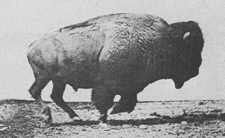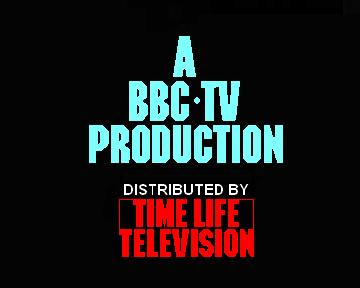

 |
 |
So what’s the story with The General? I mean, what’s the correct projection speed? This has caused personal arguments over the past 30 years or so, and that’s why I decided to settle the matter once and for all. But first, let’s get clear on the basics.
(1) Some people insist that the camera speed in The General was the same as the modern camera speed, namely, 24 frames per second, or 90 feet per minute. I can fully understand how people can watch the film at 24fps and think that the action looks normal. Action divorced from sound creates a powerful illusion. But for those of you who believe that the film was shot at 24fps, please try to imitate the actions while you’re watching the film. In actuality, apart from the special-effects shots, the film was shot at speeds ranging from 16fps to 19fps. A few second-unit sequences seem to have been shot at slightly less than 16fps, but until I can experiment with a print on a variable-speed projector, I can’t swear to that.
(2) Kevin Brownlow wrote (in the introduction to Paolo Cherchi Usai’s Burning Passions) that Buster Keaton wanted the film shown at 24fps. He didn’t state his source, though. In any case, in his video edition of the film (until recently the best by far of all the video releases, and now sadly out of print), he chose a projection speed of 25fps, and in part of the second reel 26fps.
(3) David Shepard prefers the film to be run at 26fps, and transferred it that way for the Kino video release.
(4) The instructions that were taped onto the modern replacement leaders and tails of the 35mm Rohauer print that I ran in August 2001 stated “20fps.” Who wrote these instructions, I don’t know. It could have been someone at the Rohauer Collection. Or it could have been a projectionist.
(5) In my personal experience, The General got many more laughs when projected at 18fps than when it was projected at 24fps. But different audiences react differently to different things for different reasons at different times. The film also works astoundingly well at 24 or 25fps.
(6) Æons ago in an ancient Blackhawk catalog there was an article about projection speeds, and it stated that the cue sheets for The General specified a speed of 32fps. I wish I could find that old Blackhawk catalog. But when I left home I physically couldn’t take all my belongings with me. And my parents decided not to wait for me to come by to collect everything, but instead threw almost everything into the trash. So you’ll just have to rely on my normally trustworthy memory.
(7) Daniel Moews (pronounced Maze) in the bibliographical and filmographical appendix to his book Keaton: The Silent Features Close-Up, wrote that he had examined the cue sheets for The General, added up the total timings of all the cues, and got a running time of just under 62 minutes, which arithmetically works out to a speed of just over 32fps. He also noted that the cue sheets reference a scene missing from all current prints: 20, “Officers Leave Train.”
Okay, okay, okay. Thanks to my buddy Art Pierce of the Capitol Theatre in Rome (New York, not Italy), I now have photocopies of the cue sheets, which I hereby post. Rather than tally the lengths of the cues, I decided to compare the stated length of each cue against the actual length when projected at 24fps (or actually, the NTSC video speed of 23.976fps). For this experiment, I used the old Kino edition (pre-Shepard) with the Gaylord Carter organ score. This particular video is the only one I have access to that is both complete and run at exactly 23.976fps. Here is what we get:
| Cue | VCR Counter | Stated Length | Actual Length at NTSC speed | |
| 1 | At screening | 0:00:00 | ½ | 0:49 |
| 2 | The Western and Atlantic Flyer | 0:00:49 | 1 | 1:08 |
| 3 | There were two loves | 0:01:57 | 1 | 1:15 |
| 4 | Enters house | 0:03:12 | ½ | 0:56 |
| 5 | Fort Sumpter [sic] has been fired upon | 0:04:16 | 1 ¼ | 1:29 |
| 6 | Recruiting station | 0:05:50 | 3 ¼ | 3:40 |
| 7 | Johnny back at locomotive | 0:09:30 | 1 ¾ | 1:55 |
| 8 | A year later | 0:11:25 | 1 ½ | 1:41 |
| 9 | Insert—Marietta | 0:13:06 | ¾ | 0:44 |
| 10 | Train pulls out | 0:13:50 | ¾ | 0:15 |
| 11 | Passengers alight from train | 0:14:05 | ½ | 0:49 |
| 12 | Yankees hop train—escape | 0:14:54 | 2 ½ | 3:06 |
| 13 | Those men stole my General | 0:18:00 | 3 ½ | 3:56 |
| 14 | Loads cannon again | 0:21:56 | 3 | 4:34 |
| 15 | Johnny bounces ties from track | 0:26:30 | 2 ¼ | 2:50 |
| 16 | The Southern army | 0:29:20 | 1 | 1:12 |
| 17 | General Parker’s victorious army | 0:30:32 | 1 ¾ | 2:13 |
| 18 | Johnny leaves locomotive | 0:32:45 | 1 | 0:54 |
| 19 | Johnny sneaks into house | 0:33:39 | 2 | 3:30 |
| 20 | Officers leave train [sic] | 0:37:09 | 3 ½ | 4:43 |
| 21 | It was so brave of you | 0:41:52 | ½ | 0:28 |
| 22 | After a nice quiet, refreshing | 0:42:20 | ½ | 0:45 |
| 23 | Activity at railroad | 0:43:05 | 2 ¼ | 2:08 |
| 24 | Johnny starts walking with bag | 0:45:13 | ½ | 0:21 |
| 25 | Johnny socks officer | 0:45:34 | 2 ¾ | 4:28 |
| 26 | We must pick up more wood | 0:49:58 | 1 ¼ | 1:44 |
| 27 | Engine approaching | 0:51:42 | 2 ½ | 3:10 |
| 28 | Get away from water tower | 0:54:52 | 2 ¾ | 2:15 |
| 29 | Pulls switch | 0:58:07 | 2 ¼ | 3:12 |
| 30 | The Northern division | 1:01:19 | ½ | 0:31 |
| 31 | Pours kerosene oil on logs | 1:01:50 | 1 ½ | 1:59 |
| 32 | Train pulls into station | 1:03:49 | ¾ | 1:13 |
| 33 | Southern commander at head of troop | 1.05:02 | 1 | 1:32 |
| 34 | Northern soldiers at switch | 1:06:34 | 2 ¼ | 2:30 |
| 35 | Battle starts | 1:09:04 | 3 ¼ | 4:13 |
| 36 | Heroes of the day | 1:13:17 | ¾ | 1:00 |
| 37 | Johnny sees officer on floor of engine | 1:14:17 | 1 ¼ | 1:30 |
| 38 | Is that your uniform | 1:15:47 | ½ | 0:58 |
| 39 | He puts on new uniform coat | 1:16:45 | ¾ | 0:53 |
| 40 | Sits on engine | 1:17:38 | ¾ | 1:02 |
| THE END | 1:18:40 | |||
| TOTAL | 1:18:40 | 61 ¾ | 77:52 |
So what does this mean?
First, when you look at the cue sheets, you will see that there is no projection speed specified at all.
Second, the stated lengths of the cues bear no real resemblance to their actual length at all. Most are much shorter. A few (10 and 28) are much longer. A few are about the same. All are rounded to the nearest alleged quarter of a minute. The stated lengths are obviously just vague approximations, and were never clocked against the film. Rick Benjamin of the Paragon Ragtime Orchestra confirmed my suspicions when he wrote to me that: “Music cue sheets were notoriously unreliable in the timing department. They’re best taken as a guide to action rather than of timing.”
Third, there are numerous typos in the cues. Johnnie is misspelled Johnny. Fort Sumter is misspelled Fort Sumpter. Cue number 20, “Officers leave train,” is obviously a misprint for “Officers leave room.” Check the approximate timing, check the musical cue, and then check against the film. There is no other possible interpretation. It was definitely a misprint, not a reference to a now-lost scene.
Fourth, there is good reason to suspect that the instructions regarding speed were printed on the original leaders. Has anyone out there ever seen the original leaders? By the time I got to examine a Rohauer print of the film a few years ago, the original leaders had been replaced by modern ones—and the image had been reduced to the Academy aperture, and a music track had been added, and the main title was replaced. So much for that investigation.
So what’s the proper speed? For those who say 32fps, my advice is to try running a 35mm film at 32fps and tell me what you experience. For those who say 16fps or 18fps or 20fps, please note that US films were simply not run at those speeds in the 1920s, especially not in the late 1920s. Not at all. Under any circumstances. Hardly ever. By 1926 and 1927, US films were generally run between 80 and 95 feet per minute, or in other words between about 21fps and 25fps, usually toward the upper end of that spectrum. If you’re one of those rare ones who think that Clyde Bruckman and Joseph Von Sternberg and Frank Herbert Richardson knew what they were talking and writing about when they insisted that silent films should be run at camera speed, you’ve got a long, hard, painful baptism awaiting you. I was once one of those people who trusted that those who were there, directly involved, who specialized in this field, surely knew whereof they spoke. Boy was I crushed! Some day, in the foreseeable future, I’ll spell out all the particulars, with copious references.
CONCLUSION: I don’t know, but I’m happy about the film being run at 24 or 25fps.
To examine the cue sheets for yourself, click here. Have fun!